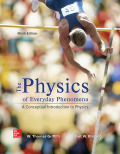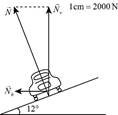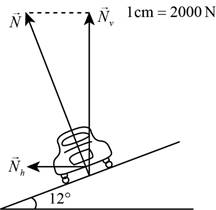
Concept explainers
A car with a mass of 1100 kg is traveling around a curve with a radius of 50 m at a constant speed of 25 m/s (56 MPH). The curve is banked at an angle of 12 degrees.
- a. What is the magnitude of the centripetal acceleration of the car?
- b. What is the magnitude of the
centripetal force required to produce this acceleration? - c. What is the magnitude of the vertical component of the normal force acting upon the car to counter the weight of the car?
- d. Draw a diagram of the car (as in fig. 5.8) on the banked curve. Draw to scale the vertical component of the normal force. Using this diagram, find the magnitude of the total normal force, which is perpendicular to the surface of the road.
- e. Using your diagram, estimate the magnitude of the horizontal component of the normal force. Is this component sufficient to provide the centripetal force?
(a)
The magnitude of the centripetal acceleration of the car.
Answer to Problem 3SP
The magnitude of the centripetal acceleration of the car is
Explanation of Solution
Given Info: The radius of the curve is and the speed of the car is
Write the equation for the centripetal acceleration.
Here,
Substitute
Conclusion:
Thus the magnitude of the centripetal acceleration of the car is
(b)
The magnitude of the centripetal force required to produce the centripetal acceleration.
Answer to Problem 3SP
The magnitude of the centripetal force required to produce the centripetal acceleration is
Explanation of Solution
Given Info: The mass of the car is
Write the equation for centripetal force.
Here,
Substitute
Conclusion:
Thus the magnitude of the centripetal force required to produce the centripetal acceleration is
(c)
The magnitude of the vertical component of the normal force acting upon the car to counter the weight of the car.
Answer to Problem 3SP
The magnitude of the vertical component of the normal force acting upon the car to counter the weight of the car is
Explanation of Solution
Given Info: The mass of the car is
The vertical component of the normal force acts to counter the weight of the car so that vertical component of normal force is equal to the weight of the car.
Write the equation for the weight of the car.
Here,
The value of
Substitute
Conclusion:
Thus the magnitude of the vertical component of the normal force acting upon the car to counter the weight of the car is
(d)
Diagram of the car on the banked curve to scale the vertical component of the normal force and determine the magnitude of the total normal force.
Answer to Problem 3SP
The diagram of the car on the banked curve is

and the magnitude of the total normal force is
Explanation of Solution
Given Info: The angle of banking of the curve is
The diagram of the car in the curve is shown in figure 1.

Figure 1
Write the equation for the vertical component of the normal force.
Here,
Rewrite the above equation for
Substitute
Conclusion:
Thus the diagram of the car on the curve is drawn in figure 1 and the magnitude of the total normal force is
(e)
The magnitude of the horizontal component of the normal force and whether it is sufficient to provide the centripetal force.
Answer to Problem 3SP
The magnitude of the horizontal component of the normal force is
Explanation of Solution
Given Info: The angle of banking of the curve is
Write the equation for the horizontal component of the normal force.
Here,
Substitute
Conclusion:
Thus the magnitude of the horizontal component of the normal force is
Want to see more full solutions like this?
Chapter 5 Solutions
Physics of Everyday Phenomena
- An L-C circuit has an inductance of 0.410 H and a capacitance of 0.250 nF . During the current oscillations, the maximum current in the inductor is 1.80 A . What is the maximum energy Emax stored in the capacitor at any time during the current oscillations? How many times per second does the capacitor contain the amount of energy found in part A? Please show all steps.arrow_forwardA long, straight wire carries a current of 10 A along what we’ll define to the be x-axis. A square loopin the x-y plane with side length 0.1 m is placed near the wire such that its closest side is parallel tothe wire and 0.05 m away.• Calculate the magnetic flux through the loop using Ampere’s law.arrow_forwardDescribe the motion of a charged particle entering a uniform magnetic field at an angle to the fieldlines. Include a diagram showing the velocity vector, magnetic field lines, and the path of the particle.arrow_forward
- Discuss the differences between the Biot-Savart law and Coulomb’s law in terms of their applicationsand the physical quantities they describe.arrow_forwardExplain why Ampere’s law can be used to find the magnetic field inside a solenoid but not outside.arrow_forward3. An Atwood machine consists of two masses, mA and m B, which are connected by an inelastic cord of negligible mass that passes over a pulley. If the pulley has radius RO and moment of inertia I about its axle, determine the acceleration of the masses mA and m B, and compare to the situation where the moment of inertia of the pulley is ignored. Ignore friction at the axle O. Use angular momentum and torque in this solutionarrow_forward
- A 0.850-m-long metal bar is pulled to the right at a steady 5.0 m/s perpendicular to a uniform, 0.650-T magnetic field. The bar rides on parallel metal rails connected through a 25-Ω, resistor (Figure 1), so the apparatus makes a complete circuit. Ignore the resistance of the bar and the rails. Please explain how to find the direction of the induced current.arrow_forwardFor each of the actions depicted, determine the direction (right, left, or zero) of the current induced to flow through the resistor in the circuit containing the secondary coil. The coils are wrapped around a plastic core. Immediately after the switch is closed, as shown in the figure, (Figure 1) in which direction does the current flow through the resistor? If the switch is then opened, as shown in the figure, in which direction does the current flow through the resistor? I have the answers to the question, but would like to understand the logic behind the answers. Please show steps.arrow_forwardWhen violet light of wavelength 415 nm falls on a single slit, it creates a central diffraction peak that is 8.60 cm wide on a screen that is 2.80 m away. Part A How wide is the slit? ΟΙ ΑΣΦ ? D= 2.7.10-8 Submit Previous Answers Request Answer × Incorrect; Try Again; 8 attempts remaining marrow_forward
- Two complex values are z1=8 + 8i, z2=15 + 7 i. z1∗ and z2∗ are the complex conjugate values. Any complex value can be expessed in the form of a+bi=reiθ. Find θ for (z1-z∗2)/z1+z2∗. Find r and θ for (z1−z2∗)z1z2∗ Please show all stepsarrow_forwardCalculate the center of mass of the hollow cone shown below. Clearly specify the origin and the coordinate system you are using. Z r Y h Xarrow_forward12. If all three collisions in the figure below are totally inelastic, which will cause more damage? (think about which collision has a larger amount of kinetic energy dissipated/lost to the environment? I m II III A. I B. II C. III m m v brick wall ע ע 0.5v 2v 0.5m D. I and II E. II and III F. I and III G. I, II and III (all of them) 2marrow_forward
 Glencoe Physics: Principles and Problems, Student...PhysicsISBN:9780078807213Author:Paul W. ZitzewitzPublisher:Glencoe/McGraw-Hill
Glencoe Physics: Principles and Problems, Student...PhysicsISBN:9780078807213Author:Paul W. ZitzewitzPublisher:Glencoe/McGraw-Hill
 Physics for Scientists and Engineers: Foundations...PhysicsISBN:9781133939146Author:Katz, Debora M.Publisher:Cengage Learning
Physics for Scientists and Engineers: Foundations...PhysicsISBN:9781133939146Author:Katz, Debora M.Publisher:Cengage Learning Physics for Scientists and Engineers with Modern ...PhysicsISBN:9781337553292Author:Raymond A. Serway, John W. JewettPublisher:Cengage Learning
Physics for Scientists and Engineers with Modern ...PhysicsISBN:9781337553292Author:Raymond A. Serway, John W. JewettPublisher:Cengage Learning College PhysicsPhysicsISBN:9781285737027Author:Raymond A. Serway, Chris VuillePublisher:Cengage Learning
College PhysicsPhysicsISBN:9781285737027Author:Raymond A. Serway, Chris VuillePublisher:Cengage Learning College PhysicsPhysicsISBN:9781938168000Author:Paul Peter Urone, Roger HinrichsPublisher:OpenStax College
College PhysicsPhysicsISBN:9781938168000Author:Paul Peter Urone, Roger HinrichsPublisher:OpenStax College





